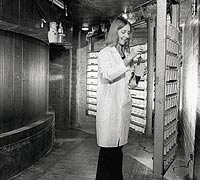Argonne's Nuclear Science and Technology Legacy
Historical News Releases
 About the Historical News Releases
About the Historical News Releases
This is an archived
Argonne News Release Item about the lab's nuclear energy legacy.
For similar items: Nuclear Energy Historical News
Releases
For more information, please contact at Argonne.
Research helps safeguard nuclear workers worldwide
ARGONNE, Ill. (Aug. 3, 1996) -- A small facility at Argonne National Laboratory played a big role in safeguarding people around the world who work with radioactive materials at nuclear power plants, hospitals and laboratories.
Argonne's "Janus" reactor began its program of experiments in radiation biology and risk assessment 32 years ago Saturday, Aug. 3. The small facility was shut down in 1992 and emptied of nuclear fuel.
The main goal of research at Janus was to determine the effects of neutron radiation, both in short, high-intensity doses and long-term exposure.
Janus featured a pair of rooms for irradiation experiments on opposite sides of the reactor core. Thick doors allowed neutrons from the reactor core to enter the rooms -- hence the name Janus, the two-faced Roman god of doorways.
Thousands of mice were irradiated in Janus's "high-flux" room over the life of the reactor. Radiation biology data from research at Janus are still used world-wide for assessing risk to people exposed to radiation.

Argonne's JANUS reactor was the world's first nuclear reactor designed and built solely for biological
research. Click on photo to view a larger image.
Download image from
Flickr
"Janus allowed us to grind out the kind of information you need to make sensible decisions about human health and safety," said Douglas Grahn, who headed radiation biology research at Janus for many years.
Some of the results were controversial, Grahn said. For example, Janus research found that low, protracted exposures to neutrons caused more damage than short, high-level doses. Similar research done elsewhere on the effects of gamma and X-rays found more tissue damage in short, high-level doses.
Despite the counter-intuitive nature of the results, the research stood because of Janus's "remarkably clean" neutrons -- the design of the high-flux room kept gamma-ray contamination to a minimum. Gamma rays, which would have complicated interpretation of the data, were reduced to negligible levels by special shielding arrangements -- including a four-inch-thick lead lining in the high-flux room.
"When we said something was neutron-induced, it was neutron-induced," Grahn said. "Janus was the cleanest source of neutrons available to anyone."
The last operating reactor at Argonne's Illinois site, Janus was shut down for the last time in April 1992.
Related Information
- Reactors Designed by Argonne National Laboratory: Basic and Applied Science Research Reactors - For more information about JANUS and other reactors designed, built, and operated by Argonne that collectively produced a vast amount of data and analysis that drove advancements in radiation protection, biosciences, reactor design, and evolution of materials used in reactor construction.
Last Modified: Wed, September 25, 2013 9:23 PM


